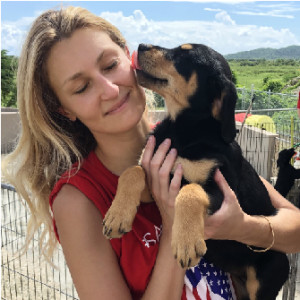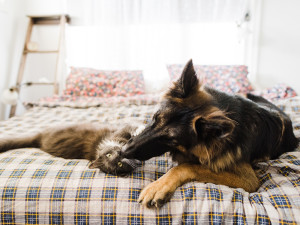How to Photograph Your Pet Like a Pro
The world needs cute pet pics. Here are five tips to go from amateur to Annie Leibovitz

Share Article
Thanks to the likes of Gerrard Gethingsopens in new tab, Elke Vogelsangopens in new tab and Seth Casteelopens in new tab, pet photography has been elevated to an art form. Sure, your portrait-mode pictures may not win you the Comedy Pet Photo of the Year, but you don’t need to be a pro to get your pet ready for their close-up, and when better to try than National Dog Photography Day?
When artist, rescue advocate and Kinship Collective member Sophie Gamandopens in new tab began shooting her Pit Bull Flower Poweropens in new tab series, I assisted by handling the shelter dogs as she captured their best ‘adopt me’ mugs. In between being jumped, slobbered and peed on by dogs who didn’t know ‘sit’ from ‘stay’, I picked up a few tips and tricks for getting the money shot.
1. Location scout
If you’re reading this, then you probably don’t have a professionally lit studio at your disposal. If your subject is a dog, natural lighting is the next best thing – the golden hour shortly after sunrise to be exact. Your dog may be more alert and animated outdoors, which is great for capturing their personality, but be sure to scout a setting without distractions like other dogs or squirrels.
Your cat, on the other hand, might not be as cool with an on-location shoot. They’ll make for more cooperative talent where they are most comfortable – ideally somewhere there is bright light, like beside a window. And consider the background – it should be neutral and clutter-free. A solid colour wall works well, or you can find seamless paper backdrops at art supply shops.
Black animals are the exception to this rule. They are notoriously challenging to shoot as their dark, monochromatic fur overshadows their features and bright light can backfire, resulting in a ‘colour cast’. Clouds can act like a natural diffuser so a softly lit, shaded area is ideal for bringing out the best side of your black cat or dog.
2. Chill them out
But not so much that your model falls asleep on the job. Walk your dog or play with your cat to burn energy so they don’t get restless when you’re trying to get them to sit for their portrait. This will also give them – dogs at least – a chance to relieve themselves and not interrupt the shoot with a potty break. If your pet has no chill, try catnip (if it doesn’t have the opposite effect on your cat).
3. Set up your camera (app)
First, turn off the flash – it can startle an animal, not to mention cast a diabolical glare in their eyes. Then check your camera app to ensure it’s set to taking high-resolution images. Portrait mode is designed to subtly blur a background and sharpen the focus on the subject. Burst mode is another handy feature, which snaps dozens of shots in rapid succession, giving you the best chance of capturing the hot second your pet makes eye contact. (If you don’t have an iPhone, you can always ‘fix it in post’ and create similar effects with basic photo editing tools.)
4. Pose your pet
If you can wrangle a friend to help (who wouldn’t want to PA a pet photoshoot?) teamwork will make the process infinitely easier. An extra set of hands can hold or keep your pet engaged while you focus on getting the shot. If you’re on your own, ask your dog to sit or place your cat where you want them – facing the camera and the light – and hope they stay put. Slowly back away and drop down to their eye level. If you have a Velcro dog or cat you’ll probably need to stay close by; in that case, fashion a makeshift tripod and set your camera’s shutter timer. Either way, let your pet sniff the spot and make themselves comfortable before starting to shoot.
5. Get the shot
With the exception of William Wegman’s Weimaranersopens in new tab, animal subjects don’t take artistic direction too well, so you’ll need to get (and keep) their attention. This is where tools come in. High-value treats, squeaky toys, a shrill voice – break out something that’s new to them so they can’t keep their eyes off it. If you have a food-motivated dog hold the treat – and their gaze – just above your head. Up the ante by making a funny noise, cueing a classic head tilt. A squeaky toy has the same desired result but squeak at your own risk (remember, you’re on your dog’s level). Cats are less command-oriented, so if an old-school pssst doesn’t do the trick, a cat wand should catch their eye. That moment of contemplation pre-pounce could be the money shot.
If you want to recreate Gamand’s goofy tongue-waggingopens in new tab look, put a dab of peanut butter on your dog’s nose. Want your dog to wave hiopens in new tab? Ask them to ‘shake’ and edit your hand out later. Finally, don’t give up when your dog gets sleepy – yawnsopens in new tab look like hearty laughs on camera.

Samantha Gurrie
Samantha Gurrie is Kinship’s Editor-in-Chief. She was previously the senior editor at NYLON magazine, co-publisher of Four&Sons, and director at Puerto Rican dog rescue The Sato Project. She lives in L.A. with her husband and rescued Pit Bull Midnight.
Related articles
!["Claws Monet" print by Niaski of a black cut swimming in a pond with water lilies in the style of Claude Monet's Water Lilies]()
Niaski is Where Art Fandom Meets Cat Obsession
From Salvador Catli to Frida Catlo and Clawed Monet, illustrator Nia Gould creates whimsical products for pets and their people
![A German shepherd and cat play affectionately in a bed.]()
The Real Differences Between Cats and Dogs
There’s no winning this argument, but here’s what you should know about parenting each perfect pet
![Woman sitting on couch with dog laying on lap watching TV]()
What Dogs See When They Watch TV
Can your dog really see what you see when they watch TV?
![Short haired woman holding a gray cat that's playfully pawing at her nose]()
Does Your Cat’s Fur Pattern Determine Their Personality?
It’s a little more complicated than that






